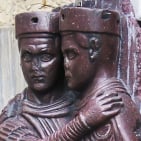About German Eszett

mauro sacchetto
Posts: 353
In German Eszett exists in fact only in lowercase. However there is another slot for the capital Eszett (uni1E9E, Latin Capital Letter Sharp S), although I do not know that any use is made of it.
My question, however, concerns the capitalized version.
Since this is an exclusively lowercase letter, it should be replaced with double smallcap S (SS).
For example, EBGaramond contains only the small capital version consisting of two S smallcaps.
Strangely enough, Junicode presents both the version consisting of two smallcap SS, and the design of a small capital Eszett, which it then calls germandbls.sc1; for the latter, however, there is no replacement in the lookups, so I don't understand if the .sc1 extension is just a trick to leave the glyph inside the font without foreseeing any use.
What is the most correct behavior to adopt?
Thank you
ms
Strangely enough, Junicode presents both the version consisting of two smallcap SS, and the design of a small capital Eszett, which it then calls germandbls.sc1; for the latter, however, there is no replacement in the lookups, so I don't understand if the .sc1 extension is just a trick to leave the glyph inside the font without foreseeing any use.
What is the most correct behavior to adopt?
Thank you
ms
Tagged:
0
Comments
-
As a very quick answer: do not replace SS with Eszett in any automatic way. Firstly, because it is used only in Germany and the German language is also used in Switzerland, Liechtenstein, and Italy. Secondly, because not all SS cases are replaceable by the Eszett.
Eszett was discussed at length in other threads. I suggest you to do a search to find more information.
1 -
This is a lengthy thread on the eszett: https://tinyurl.com/ql9h8vu
1 -
mauro sacchetto said:In German Eszett exists in fact only in lowercase. However there is another slot for the capital Eszett (uni1E9E, Latin Capital Letter Sharp S), although I do not know that any use is made of it.Short answer: This is false nowadays. The ẞ is an official part of German spelling, and people do use it (although the use is not very widespread yet).If your typeface doesn’t offer ẞ, don’t list German among the languages your font supports. (It’s really not a big deal to add it, though.)3
-
Thank you for your answers. But what have I to conclude about smallcap Eszett? Ok about no automatic replacemente. But in the smallcap have I to put a double SS, or the classical Eszett glyph in a proper dimension? ANd, finally, which does it mean .sc1 whitout substitution in any lookup?0
-
IIRC the link I provided includes a discussion about the smallcap eszett.
0 -
At least in Adobe apps, ß is replaced by SS by the application before applying opentype features, so your font doesn’t need to deal with this (in fact, it can't, since ß will never be passed to your small caps lookup by the application).mauro sacchetto said:Thank you for your answers. But what have I to conclude about smallcap Eszett? Ok about no automatic replacemente. But in the smallcap have I to put a double SS, or the classical Eszett glyph in a proper dimension?
It's not clear what you're asking here. Can you provide an actual example of the code you are asking about?ANd, finally, which does it mean .sc1 whitout substitution in any lookup?2 -
The only feature inclusion of small cap Eszett should be from the capital Eszett in <c2sc>:
<div>feature c2sc {</div><div> sub @c2sc_source by @c2sc_target;</div><div>} c2sc;</div>
Include uni1E9E in the source, and uni1E9E.c2sc in the target.4 -
Replace ß <-> SS is application level and old casefolding, i. e. before Unicode assigned
'ẞ' U+1E9E LATIN CAPITAL LETTER SHARP S (Uppercase_Letter)
as a character, the small ß was casefolded to uppercase SS. Now, since ẞ exists, just treat it as fontmaker like any other capital letter. It's a problem of the user or his application, if he wants to use ẞ, SS or SZ.
2 -
Smart software will perform a case conversion of ß -> SS and then apply the c2sc (cap-to-smallcap) feature. Arguably, all smallcaps with corresponding case mappings should be handled in this way, but definitely those with special casing rules. Ideally, the smcp feature mapping lowercase-to-smallcaps would only be needed in exceptional cases. And by exceptional cases I mean the smallcap forms of some lowercase-only characters that I include in the Brill types.

0 -
In Junicode font there is a glyph for the capital Eszett which simply consists of two S smallcaps side by side as a single glyph: it is called germandbls.sc. But there is also another glyph similar to a real Eszett like the capital one, but smaller, which is called germandbls.sc1. This glyph is not included in any replacement lookup, so I was wondering if it was just a trick to keep an extra glyph inside the font, although without actual use.
0 -
In Junicode, we have
sub germandbls by germandbls.sc
in the 'smcp' lookup andsub uni1E9E by germandbls.sc1
in the 'c2sc' feature.
The first substitution isn't really necessary, but it subsitutes ß with a small capital ss ligature. This may have been included to support older software which doesn't handle ß casing properly.
The second substitution replaces uppercase Eszett with a true small capital as is appropriate.1
Categories
- All Categories
- 46 Introductions
- 3.9K Typeface Design
- 487 Type Design Critiques
- 564 Type Design Software
- 1.1K Type Design Technique & Theory
- 656 Type Business
- 861 Font Technology
- 29 Punchcutting
- 520 Typography
- 119 Type Education
- 324 Type History
- 77 Type Resources
- 112 Lettering and Calligraphy
- 33 Lettering Critiques
- 79 Lettering Technique & Theory
- 558 Announcements
- 94 Events
- 114 Job Postings
- 170 Type Releases
- 179 Miscellaneous News
- 276 About TypeDrawers
- 54 TypeDrawers Announcements
- 120 Suggestions and Bug Reports





